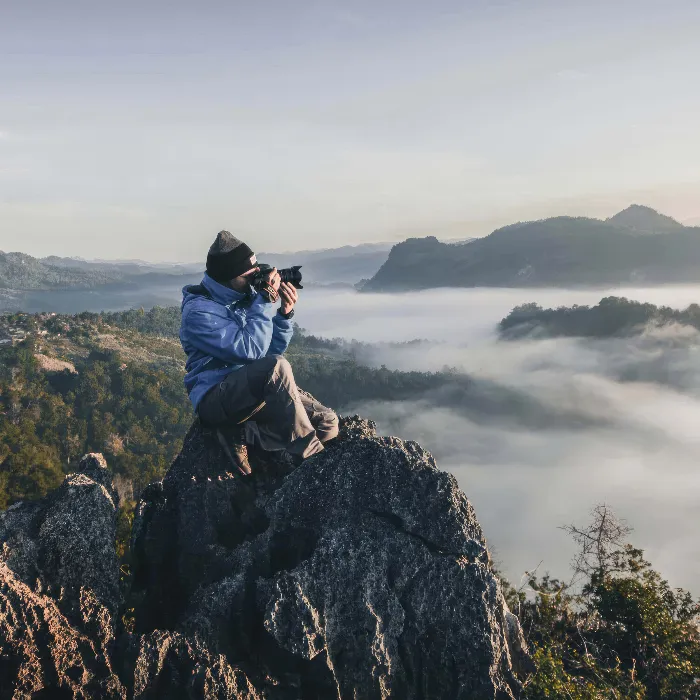Landscape Photography opens up a world of possibilities for capturing impressive scenes and striking subjects. Whether you are photographing the gentle hills of the countryside or the majestic mountains of the Alps, there are some techniques that can elevate your images to a new level. This is the third part of a series in which I provide you with valuable tips on this fascinating topic. Let’s dive right in and discover the secrets of landscape photography.
Key Insights
- The blue hour after sunset offers fantastic lighting conditions.
- Pay attention to order in your images: avoid distracting elements.
- Incorporate size ratios through objects or people in your images.
- Experiment with different perspectives to change the impact of the image.
- Use vertical format for unique compositional approaches.
Step-by-Step Guide
1. Use the Light of the Blue Hour
In landscape photography, light plays a crucial role. It is not only the sunset that creates captivating images; the blue hour after the sunset has its own special charm. This time provides soft light that highlights the details of the landscape and creates an atmosphere that is hard to replicate. If you have the opportunity to wake up early and try this at sunrise, it will significantly impact the quality of your images. An example of such a situation could be found in your own garden or in a park to capture the light at its best moment.
2. Maintain Order in Your Images
A common problem in landscape photography is distracting elements in the image. You should ensure that no disturbing objects, such as cars or pedestrians, interfere with your subject. Especially in photographs of buildings, it is essential to avoid such elements during the shoot. If you happen to have unwanted objects in the image, they can be retouched later. Any element that does not fit into the overall picture distracts the viewer and disrupts the perception of the landscape. It is worthwhile to look carefully at what is visible in the image before triggering the camera.

3. Incorporate Size Ratios in Your Images
Using objects that emphasize the size of your landscape can help create a reference for the viewer. For example, photograph a majestic mountain and add a tree or a small building in the foreground. This way, the viewer can more clearly recognize how large the mountain really is. This not only gives the image depth but also helps the viewer interpret the subject better. Be sure to consciously incorporate such size ratios into your composition.
4. Vary Your Perspective
Perspective is often an underestimated aspect of landscape photography. By experimenting with different angles, you can fundamentally change the impact of the image. For example, photograph from a higher position or lie on the ground for an interesting perspective. You will see how different the results are. An example of a successful perspective change could be your experience in a city like Florence, where you used a viewpoint. This variety in perspectives increases the dynamism of your images and can make them unique.
5. Use the Vertical Format
The vertical format in landscape photography offers you another opportunity to create interesting compositions. The vertical orientation can better highlight lines and structures in the landscape. Images taken in portrait orientation are often less common and therefore draw more attention. If the landscape allows, experiment with vertical photographs to make your captures more vibrant and impressive. Careful consideration of line direction and rules like the rule of thirds are also important here.
Summary - Landscape Photography: Master the Key Tips for Impressive Images
In summary, lighting conditions, orderly image composition, the representation of size ratios, as well as perspective changes and experimenting with different formats are crucial for successful landscape shots. Each of these elements contributes to making the image impressive and appealing. Apply these tips in your upcoming photography to further develop your skills and create stunning landscape images.
Frequently Asked Questions
What is the blue hour in photography?The blue hour refers to the short period after sunset during which the light is soft and atmospheric.
Why is order in the image important?Order ensures that the viewer is not distracted by disturbing elements and can better perceive the main subject.
How can I represent size ratios in my images?By incorporating known objects like trees or buildings, you can influence the perception of the size of the landscape.
What perspectives should I try in landscape photography?Try different heights and angles, e.g., from above or below, to change the image’s impact.
How can vertical format improve my landscape photography?In vertical format, interesting lines and structures are often better represented, leading to unique compositions.


